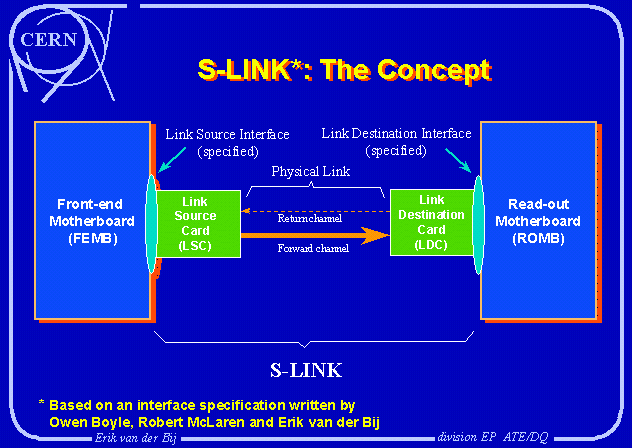

In many applications a uni-directional data channel will be required. In other cases the user might require to send flow control and other information back to the FEMB. The S-LINK, therefore, can be constructed in either a simplex or a duplex version.
In the simplex version, there is no communication path between the LDC and the LSC. That is, data can be sent in one direction only and data which is transferred to the LSC will be transmitted to the LDC and transferred to the ROMB. An S-LINK of this type could be implemented over a single fibre and is targeted at applications where the number of read-out channels is very large (perhaps several thousand). The immediate consequence of this is that no flow control is possible and every word transferred to the LSC will subsequently be transferred out by the LDC. The user should therefore ensure that the ROMB can always handle the data stream coming from the S-LINK.
In the duplex version, a return channel exists which allows the LDC to pass information back to the LSC. The main function of this return channel is to transmit flow control commands from the ROMB to the FEMB. Thus a duplex S-LINK transmits only when the ROMB is available to read the data. When the ROMB is unavailable, data transfers from the FEMB to the S-LINK are inhibited. In addition, the return channel may be used to transmit signals on a set of return lines.
S-LINK links have been built that use optical and electrical cables and that use different components driving the links. Also interfaces from PCI and PMC to S-LINK are made and drivers for various operating systems are available (Linux, LynxOS, VxWorks, Windows NT). Furthermore test tools that can be used to help in writing software and to debug FEMBs, ROMBs and links are designed. Most of the devices are commercially available direct from companies based in The Netherlands, Hungary and Poland.
S-LINK and the S-LINK concept are used in the following fields:
CERN is willing to grant licences for use of the S-LINK specification;
don't hesitate to contact us
for details.
CERN - S-LINK
Erik van der Bij - 19 May 2000
- Copyright